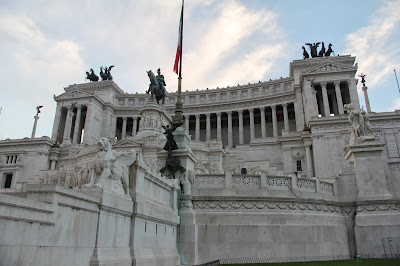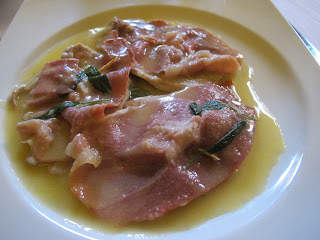On October 5 we said goodbye to Campo Santo, and took the
vaporetto water taxi to the
Venice railroad station
where we caught a Ferrari-red Treno Italo, a relatively new privately-owned and moderately-priced high speed train to
Rome.
 |
| The treno Italo we took from Venice to Rome-Ferrari Red! |
We thought it would be fun to see some more Italian countryside, which we did,
but there were many tunnels between
Bologna and
Florence. Reading about it afterwards, we learned we
went through the
Apennine Tunnel, one of the longest in the world. In all there were 73.8 km of tunnels, which
substantially shortened the trip, but not so much view! Our e-readers got us through the vista
blackout.
We detrained at the
Tiburtina station which was very close
to our lodgings, another
Intervac house exchange. Lorenzo Spaziani, our host, met us at the
station, and took us to the apartment nearby. (Lorenzo and his wife had stayed with us last year, so this was what is called a non-simultaneous
exchange.) They live in the country
outside
Rome
but their small pied-a-terre in the city is in a residential neighborhood, 10
minute walk or bus ride from the Tiburtina transportation hub. Naturally we bought 7-day passses and got to
know the bus and subway system well.
 |
| A view of our comfortable apartment in Rome |
Our neighborhood was one of apartment blocks, most of which
had shops or restaurants at street level, so most anything we could want was at
our finger tips and at prices that were much more reasonable than in the
tourist districts. Lorenzo gave us his
tips on where the grocery stores were as well as showing us around the spacious
apartment (with washing machine!) We should have known, and henceforth when do
house exchanges in
Europe, we will pack ice
cube trays. We keep forgetting that
Americans have this fixation about ice that is not shared with others. This was about the only complaint we had
about this apartment. This was not a
neighborhood for fancy restaurants, though did have many more causal places to
eat.
 |
| Ristoart restaurant near our apartment in Rome |
With the help of
tripadvisor, we found a very nice nearby restaurant for our first night.
Ristorart, Via di Cloniacensi 9/11 [pic
10/5,0486], just off the busy Via Tiburtina, had nice décor, featuring
different local artists on the walls, and a sophisticated menu that kept us
happy.
 |
| Dane's colorful pizza at Ristoart |
We had ravioli pomodoro and pizza
partenopea (like Neapolitan, with mozzarella, black olives and
anchovies). Their best beers were from Germany – we were starting to find out that even
though some excellent artisanal beers are now being made in Rome,
even the better restaurants only serve bland domestic or fancy imported beers –
sort of like the U.S.
in the 80s and 90s.
 |
| The "Wedding Cake" monument to Victor Emmanuel II |
The ancient Romans may have had a penchant for well-built,
straight roads, but you would never guess it from what exists today in the
ancient part of
Rome. The amount of ruins to see is staggering and
a bit confusing, since there are so many layers – different eras to be
explored. The national monument to
Victor Emmanuel II, also known as the
Altar of the Motherland or Il Vittoriano
or “the wedding cake” is a help. It
stands high, and the chariots of the winged victories can be seen on the
horizon from many directions to give us bearings. This monument was built to honor the first
king of a unified
Italy,
so it is a Victorian fluffery designed in 1885 and fully completed in
1935. It is just off the Piazza Venezia,
which is a transportation hub, and around the corner from the Capitoline
Museums. The Capitoline Museums are
certainly worth a visit, both the central courtyard area and the museum.
We found a useful web tool to help us keep track of what was
where:
Wikimapia.org. Of course you can
zoom in and out like Google maps but the cursor will highlight and name an area
and the closest zoom shows a picture of the building or site itself.
The area bounded by the Vitorino, the Coliseum and the
Palatine Hill, includes the
Roman Forum and is where the complete landscape is
one of ruins. Joan had to keep reminding Dane that there were more ruins in Rome than he could imagine; he was snapping pictures everywhere, and then we would find another spectacular ruin around the next corner!
 |
The Roman Forum
|
With the Palatine Hill in the background it makes for great
photography, and there are special maps posted throughout showing the before
and after which help sort it all out. We
found the Forum area to be quite walkable; we enjoyed several walking tours with
a
Frommer’s guidebook from the library.
 |
| Courtyard of the Doria Pamphilji Gallery museum |
A fabulous, undiscovered museum we visited was the Palazzo Doria Pamphilj. The home and gallery of the Pamphilj family for centuries, we wandered through sumptous apartments and galleries of fine art, including masterpieces by Caravaggio, Claude Lorrain, Bernini and the Brueghels. Just a couple blocks from the Roman Forum, it was a quiet respite from the crowds in the popular touristic sites and an experience we treasured.
 |
| Monte Testaccio |
Another time we took a walking tour of Testaccio, in the
vicinity of the metro stop Pyramide. The main geographic feature is the
Monte Testaccio,
an artificial mound composed almost entirely of fragments of broken amphorae
dating from the time of ancient
Rome which represents
the remains of over 50 million vessels that probably held 1.6 billion gallons
of olive oil used in
Rome!
See, we are not the only ones that use a lot
of oil and create big landfills. Now is
it worn down and verdant and forms the center of the very nice Testaccio
residential district. We ate at a great
neighborhood restaurant,
Il Canfinone Ristorante, Piazza Testaccio 31 where we enjoyed being surrounded by locals. Joan had a very nice
veal saltimbocca alla Romana
 |
| Veal Saltimbocca, a traditional dish of Rome. |
but the hit, at least for
Dane, was rigatoni with pajata (veal entrails with the milk still inside) in a
tomato sauce. You have to sort of
suspend cerebral functions (Dane says he is good at this) and just taste –honest,
it was good.
 |
| ! |
Also nearby, on via Benjamino Franklin was an old abattoir,
or meat processing center, which has morphed into a museum of contemporary art
called Macro Testaccio. Behind the main entry was a construct made of bamboo in the shape of a
pyramid which actually had stairs for climbing.
 |
| Bamboo installation at Macro Testaccio |
Just down the road was a city of alternate economy that had a very nice
bio market (think green and wholesome) as well as a park that was sporting a
theatrical show for kids.
 |
| Rome's pyramid under restoration taken from the Protestant Cemetery |
The metro stop, which makes this whole area so easy to get
to, is named for an actual pyramid that can be seen from the station. It was
built about 18 – 12 BCE as a tomb for Gaius Cestius, a magistrate and religious
leader, and was sited at the fork of two ancient roads. It had been incorporated into
Rome’s fortifications
which helped it become one of the city’s best-preserved ancient buildings. When we were there, the marble facing was
being restored, so pardon us for including a picture with the scaffolding.
The photograph is taken from the nearby Protestant
cemetery, established in
1738, and among those buried here are Keats and Shelley.
 |
| The English poet John Keats' grave in the Protestant Cemetery in Rome |
 |
| Eataly in Rome |
Less than a mile away, from the Pyramide area is a shopping
complex called
Eataly in a vacant air terminal building connected to the Roma Ostiense railway station. (Be careful in the Roman metro-Dane had his wallet stolen by gypsies as we were jammed into a subway car! Thank heavens for Michael Liscano's telephone-we were able to cancel the credit cards with no lasting damage.)
We have visited the Eatalys in
New York, and
Chicago, so were were happy to visit the largest one in Italy. (There are also several in
Japan-we had no idea they were global.)
 |
| Map of the Eataly locations throughout the world |
Eataly is very
Slow Food oriented, and has great produce and pasta, coffee, gelato, bread, fish, meat, pork and poultry
departments, all with restaurants. You
can purchase the best cuts or dine in a restaurant area themed to each area’s
offering. We ate in the fish area but
were also able to choose from the nearby meat market. Though it may be a big complex, the food was
anything but factory-like. We were with
a group of friends and all had spectacular meals, reasonably priced.
 |
| Enjoying our lunch at Eataly with Michael, Martha and Michael. |
Just to keep Dane happy, this Eataly even had a brew-pub and
an excellent selection of local and foreign beer in bottles and on tap (alla spina). We purchased a big bottle of local,
bourbon-barrel-aged barley-wine for a dinner party we were going to that
evening.
 |
| Dane pondering the wide variety of Italian mircobrews at Eataly Rome. |
We mention friends and a dinner party; we should
explain. Former
Queen Victoria Inn guests, Michael and Martha
Liscano, who live in Columbus,
Ohio, have become very good
friends. Before we left for Italy we discovered that they would be in Italy at the
same time as we, so we planned to get together.
Michael, an architect and artist, and Martha, who patiently puts up with
Michael’s bon homme personality and humor, go to Italy quite a bit. It turns out they have a group, who often
travel with them, and we were invited to “crash” the party. What a fun and engaging group they were. The evening of our Eataly visit, we were
going to an apartment they rented in the Trastevere area. Hence Dane took the very fancy bottle of
after-dinner beer. Everybody chipped and
helped produce a magnificent feast.
 |
| The two Michaels pondering our fish order at Eataly, Rome |
 |
| Enjoying a wonderful meal in the apartment in Trastevere with Michael and Martha's travelling friends from Ohio. |
Next: We are treated to a full-walking tour of their favorite places in Rome by Michael & Martha Liscano.































 Even stopping for a coffee and cookie was an artistic treat in Rome:
Even stopping for a coffee and cookie was an artistic treat in Rome:

























